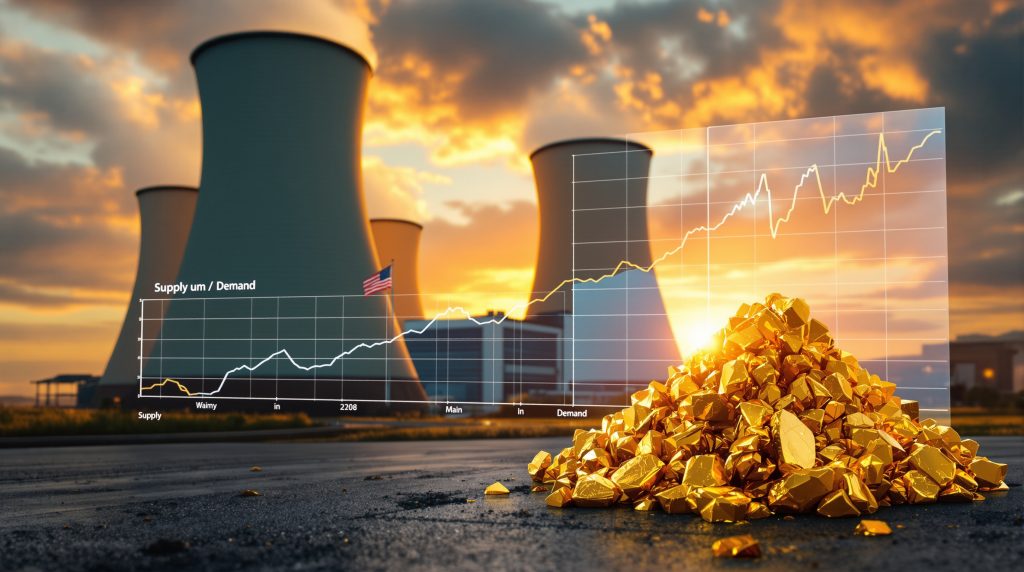Why Are US Nuclear Plants Facing a Critical Uranium Supply Shortage?
The United States nuclear sector faces a looming crisis that threatens the foundation of its energy security. Recent data from the Energy Information Administration (EIA) reveals a widening uranium supply gap projected to reach approximately 184 million pounds over the next decade—equivalent to more than three years of total consumption for domestic reactors. This alarming shortfall comes at a time when nuclear energy remains crucial to both energy stability and climate objectives.
The Widening Supply-Demand Imbalance
The US nuclear plants uranium supply gap represents a critical vulnerability in America's energy infrastructure. Less than 10% of uranium delivered to US reactors is typically purchased on spot markets, with the vast majority procured through long-term contracts that provide operational stability for nuclear facilities. However, recent uranium market volatility has disrupted traditional procurement patterns.
"High uranium costs are pushing utilities to delay decisions covering future fuel requirements," notes the October 2025 EIA report, highlighting how price volatility is complicating long-term planning for nuclear operators across the country.
This procurement hesitancy creates a dangerous cycle: as utilities delay commitments, supply uncertainty increases, potentially driving prices higher and further deterring contract decisions.
Current Supply Chain Vulnerabilities
Perhaps most concerning is America's overwhelming dependence on foreign uranium sources. Over 90% of uranium consumed by US reactors in 2024 was sourced internationally, according to EIA data. This extreme reliance on external suppliers creates significant vulnerabilities for the backbone of America's carbon-free power generation.
Domestic production currently satisfies only a minimal fraction of US nuclear fuel requirements. This imbalance has developed gradually over decades as domestic mining operations struggled to compete economically with international producers offering lower-cost uranium.
Market analysts point to the contradiction between Silicon Valley's multi-billion dollar investments in advanced reactor designs while fundamental fuel supply chains remain precarious. This technological innovation versus resource security disconnect threatens to undermine America's nuclear renaissance before it fully materializes.
How Did US Nuclear Plants Become So Dependent on Foreign Uranium?
The current uranium supply predicament didn't develop overnight. Rather, it represents the culmination of decades-long trends that have systematically eroded domestic uranium production capacity while increasing reliance on international suppliers.
Historical Decline of Domestic Uranium Industry
American uranium production has experienced a dramatic contraction since its peak in the late 1970s and early 1980s when dozens of mines operated across the western United States. Today, only a handful of operations remain active, with production levels at a fraction of historical output.
This decline stems from multiple factors, including competition from lower-cost international producers in Kazakhstan, Canada, and Australia, stricter environmental regulations increasing operational costs, and market consolidation reducing competitive pressures to maintain domestic capacity.
The economics of uranium mining in the United States has become increasingly challenging. Many domestic deposits require more complex extraction methods than their international counterparts, putting American producers at a structural disadvantage in global markets even before considering regulatory compliance costs.
The Russia Factor in US Nuclear Fuel Supply
Despite geopolitical tensions and partial import restrictions, Russia remained the top supplier of nuclear reactor fuel to the US in 2024, according to the EIA report. This continued dependence persisted even after a Senate ban on Russian uranium took effect, highlighting the challenges in rapidly restructuring nuclear fuel supply chains.
Russia's dominant position is particularly pronounced in uranium enrichment services, where it controls approximately 40% of global capacity. This enrichment step represents a critical bottleneck in the nuclear fuel cycle that cannot be quickly replaced or substituted.
"We're moving to a place—and we're not there yet—to no longer use Russian enriched uranium," US Energy Secretary Wright told Bloomberg News in September 2025, acknowledging the transition away from Russian supplies remains incomplete. The Secretary's comments underscored the need for the United States to build a stronger uranium buffer to enhance energy security.
Six months after US legislation restricted Russian uranium imports, Moscow retaliated by temporarily limiting exports of enriched uranium to the United States, demonstrating the leverage foreign suppliers maintain over America's nuclear sector and the potential for supply chain weaponization during periods of geopolitical tension.
What Are the National Security Implications of the Uranium Gap?
The strategic vulnerabilities created by America's uranium dependency extend far beyond simple supply chain concerns, directly affecting national security, energy independence, and global influence.
Strategic Vulnerabilities in Energy Infrastructure
Nuclear energy provides approximately 20% of US electricity generation and over 50% of America's carbon-free power. This baseload generation is essential for grid stability and reliability, particularly as weather-dependent renewable sources expand their contribution to the energy mix.
Supply disruptions affecting nuclear fuel availability could have cascading effects across the entire electricity system, potentially leading to grid instability, higher costs for consumers, and increased reliance on fossil fuel generation during shortages.
The US nuclear plants uranium supply gap also creates vulnerabilities in military applications, where naval propulsion and certain defense technologies depend on secured domestic fuel sources. While military uranium requirements differ from civilian power generation needs, the overall erosion of the domestic uranium industry affects both sectors.
International Relations and Energy Diplomacy
America's heavy reliance on imported uranium creates leverage for supplier nations in broader geopolitical negotiations. When critical infrastructure depends on foreign resources, diplomatic flexibility can become constrained as energy security concerns take precedence over other foreign policy objectives.
The competition with China for global uranium resources has intensified in recent years. Chinese state-backed companies have secured significant uranium mining assets in Africa and Central Asia, positioning Beijing to potentially influence future supply availability for Western markets. This resource competition represents another dimension of the broader US-China strategic rivalry.
Diplomatic challenges in securing new international supply agreements have increased as more nations prioritize domestic energy security. Traditional uranium-producing allies like Australia and Canada face their own domestic pressure to ensure resources benefit their economies first, potentially complicating efforts to diversify away from Russian supplies.
What Steps Is the US Taking to Address the Uranium Supply Gap?
The federal government has implemented several initiatives aimed at reducing dependency on foreign uranium and strengthening domestic supply chains, though implementation challenges have hampered progress in some areas.
Policy and Regulatory Initiatives
In 2024, legislation was enacted requiring US utilities to transition away from Russian uranium supplies by 2028, establishing a clear timeline for reducing dependency on Moscow's nuclear fuel. This mandate created a forcing mechanism for utilities to develop alternative supply arrangements, though implementation details remain contentious.
The White House issued Trump's critical minerals order in May 2024 intended to accelerate deployment of advanced reactors and associated fuel supply chains. This order directed federal agencies to streamline permitting processes, coordinate research investments, and identify barriers to commercial deployment of new nuclear technologies.
Proposals to establish a strategic uranium reserve similar to the petroleum reserve have gained traction, with supporters arguing that a buffer stockpile could provide insurance against supply disruptions while supporting domestic production. However, funding limitations have restricted the scale of these reserve initiatives.
Funding and Implementation Challenges
Despite policy directives, implementation has faced significant hurdles. The EIA, responsible for monitoring uranium markets and providing critical data to policymakers, lost more than 100 of its roughly 350-person workforce amid streamlining efforts in 2024-2025. These staff reductions directly impacted market monitoring capabilities, with the agency's uranium report experiencing substantial delays.
Competing budget priorities have limited funding for uranium security initiatives, forcing difficult trade-offs between immediate security concerns and longer-term investments in domestic production capacity. Some projects have received partial funding while others remain in planning phases awaiting appropriations.
The complex regulatory landscape governing uranium mining and processing creates additional implementation challenges. Multiple federal agencies hold jurisdiction over different aspects of the fuel cycle, creating coordination difficulties and sometimes contradictory requirements that slow project development timelines.
How Are Market Dynamics Affecting Uranium Supply Security?
Market forces have significantly shaped procurement patterns and investment decisions throughout the uranium supply chain, creating both challenges and opportunities for addressing the supply gap.
Price Trends and Procurement Challenges
Uranium prices have experienced substantial volatility in recent years, creating uncertainty for both suppliers and consumers. According to the EIA report, US utilities signed fewer contracts for future delivery in 2024 as uranium prices surged, illustrating how price volatility complicates long-term procurement planning.
This procurement hesitancy creates a dangerous feedback loop—as utilities delay commitments to avoid locking in high prices, suppliers lack the financial certainty needed to develop new production capacity, potentially worsening future supply constraints.
The EIA suggests more utilities may need to forge shorter-term arrangements to keep reactors operating in the absence of long-term supply deals. While this approach provides flexibility, it increases exposure to spot market volatility and reduces visibility for production planning across the supply chain.
Investment Landscape in Uranium Production
Capital allocation toward uranium projects has increased as supply concerns gain prominence, though investment remains below levels needed to fully address the projected gap. Projects that previously appeared economically marginal have become viable with higher uranium prices, potentially expanding the resource base accessible to US utilities.
The lead time for new uranium production represents a significant challenge. Developing a new conventional uranium mine typically requires 7-10 years from discovery to production, creating a substantial lag between investment decisions and supply availability. This timeline mismatch complicates efforts to rapidly address supply shortfalls.
Public market interest in uranium mining companies has grown substantially, with uranium-focused equities experiencing significant valuation increases. This capital access improvement provides development-stage companies with funding opportunities previously unavailable during the extended uranium price depression of the 2010s.
What Role Will Advanced Nuclear Technologies Play in the Supply Equation?
Next-generation reactor designs and new nuclear initiatives will significantly impact uranium requirements and could potentially exacerbate the supply gap if not addressed proactively.
Next-Generation Reactor Fuel Requirements
Advanced reactor designs often utilize different fuel compositions and enrichment levels compared to the current reactor fleet. Many Small Modular Reactor (SMR) designs and microreactors require High-Assay Low-Enriched Uranium (HALEU) with enrichment levels between 5-20% U-235, compared to the 3-5% used in conventional reactors.
This HALEU requirement creates additional supply chain challenges, as commercial-scale production capacity for these higher enrichment levels remains limited in Western nations. Russia currently dominates global HALEU supply, creating potential bottlenecks for advanced reactor deployment if domestic production isn't established.
Some advanced reactor designs offer improved fuel efficiency that could partially offset increasing deployment numbers. Technological innovations in fuel design and reactor operation potentially allow more electricity generation per pound of uranium, though these efficiencies may not fully compensate for the overall growth in reactor numbers.
Silicon Valley's Nuclear Renaissance Impact
Silicon Valley investors are pouring billions of dollars into designing next-generation nuclear reactors, according to the Bloomberg News report from October 2025. This substantial capital influx has accelerated development timelines for multiple advanced reactor concepts that could reshape the nuclear landscape.
These well-funded nuclear startups focus primarily on smaller, modular designs intended to reduce construction costs and deployment timelines compared to conventional gigawatt-scale plants. If successful, this approach could lead to more rapid nuclear expansion than previously anticipated in energy transition models.
The innovation emphasis in reactor design hasn't been matched by equivalent investment in fuel cycle infrastructure. While billions flow to reactor technology development, comparatively less capital targets the mining, conversion, and enrichment facilities needed to fuel these designs—potentially creating a bottleneck that constrains deployment.
Can Domestic Production Be Scaled to Meet US Nuclear Needs?
Expanding US uranium mining and processing capabilities presents both opportunities and challenges in addressing the supply gap, with multiple factors affecting the potential timeline and scale of domestic production growth.
Current State of US Uranium Resources
The United States possesses significant uranium resources, primarily concentrated in western states including Wyoming, Utah, Colorado, and New Mexico. The US Geological Survey estimates domestic uranium resources at approximately 31 million pounds of U3O8 at forward costs below $30/lb, with substantially more available at higher price points.
Despite this resource endowment, active uranium mining operations in the US have dwindled to just a handful of facilities. Most production currently comes from in-situ recovery operations in Wyoming, with conventional mining largely dormant despite previously productive districts maintaining significant resource potential.
The technical and geological characteristics of US uranium deposits influence production economics. Many remaining conventional resources require underground mining methods with higher operating costs than some international competitors, while in-situ recovery operations face their own technical and regulatory challenges.
Barriers to Production Expansion
Environmental permitting timelines represent a significant barrier to rapid production expansion. Developing new uranium projects typically requires extensive environmental reviews under multiple regulatory frameworks, with processes often extending 5+ years before construction can begin—even for projects with strong local support.
The uranium production workforce has contracted significantly during the extended industry downturn, creating skilled labor shortages that complicate expansion efforts. Specialized mining engineers, geologists, and processing technicians with uranium experience are increasingly scarce, requiring substantial training investments before major capacity additions.
Public perception challenges persist in some regions with uranium resources, creating additional hurdles for project development. Historical environmental impacts from earlier mining eras continue to influence community attitudes, requiring extensive engagement and demonstrated environmental protection measures to build support for new operations.
What Can We Learn from International Uranium Supply Models?
Examining how other nations have approached uranium supply security offers valuable insights for US strategy, highlighting different models for balancing domestic production, international partnerships, and strategic stockpiles.
Case Studies in Uranium Self-Sufficiency
France has developed a distinctive approach to uranium supply security despite limited domestic resources. Through strategic investments in uranium mines across Africa (particularly Niger and previously Gabon), state-backed companies secured direct access to uranium resources while developing domestic expertise in enrichment technology to capture higher value-added activities within the fuel cycle.
Canada demonstrates an alternative model, maintaining strong domestic uranium production while developing an integrated mining, refining, and fuel fabrication industry. The country's regulatory framework balances environmental protection with resource development, allowing Canada to maintain its position as a leading global uranium supplier while serving domestic needs.
Kazakhstan's rapid production expansion over the past two decades provides lessons in technical innovation and resource development efficiency. The country leveraged in-situ recovery technology to become the world's largest uranium producer while maintaining competitive costs, demonstrating how focused national strategies can rapidly transform production capabilities.
Potential International Partnerships
Strategic partnerships with allied nations offer one path to improving uranium supply security without requiring complete self-sufficiency. Coordinated approaches between the United States, Canada, Australia, and European partners could create more resilient supply chains resistant to disruption or manipulation by individual supplier nations.
Technology transfer agreements for advanced fuel production capabilities could accelerate domestic capacity development. International partnerships focused on areas like HALEU production and advanced enrichment technologies potentially allow faster capability development than purely domestic efforts.
Joint strategic reserve initiatives among partner countries could provide greater supply resilience at lower costs than individual national reserves. Shared stockpiles with coordinated management could offer insurance against supply disruptions while distributing the financial burden across multiple participants.
How Will the Uranium Gap Affect US Climate and Energy Goals?
The supply challenges could impact broader energy transition objectives and emissions reduction targets that rely on nuclear power as a key decarbonization component.
Nuclear's Role in Decarbonization Plans
Nuclear power provides approximately 20% of US electricity and over 50% of carbon-free generation, making it essential to current emissions reduction achievements. Any constraints on nuclear operations directly impact the country's carbon footprint, potentially forcing greater reliance on fossil fuels during supply shortages.
Climate models that project pathways to deep decarbonization frequently include expanded nuclear generation alongside renewable growth. The International Energy Agency and other major analytical organizations consistently identify nuclear expansion as a critical component of cost-effective decarbonization strategies, particularly for providing reliable baseload generation.
Grid stability considerations increase nuclear's importance as intermittent renewable penetration grows. Nuclear plants provide essential grid services including frequency regulation and voltage support that become more valuable in systems with high variable generation, making fuel supply security directly relevant to overall grid reliability.
Balancing Energy Security and Environmental Objectives
Trade-offs between domestic production expansion and environmental protection create policy tensions. Accelerating domestic uranium mining potentially increases local environmental impacts, while continued reliance on imports maintains supply vulnerability—requiring careful balancing of competing priorities.
Nuclear's role alongside renewable energy expansion requires integrated planning. The complementary characteristics of nuclear baseload and variable renewables create system benefits when deployed together, but require coordinated policy approaches that address both technology deployment and fuel security.
Strategic planning for maintaining the existing fleet while developing new technologies demands attention to near-term fuel requirements and longer-term supply chains simultaneously. The decade-long development timeline for new production capacity means decisions today will determine supply availability when advanced reactors begin large-scale deployment in the 2030s.
What Solutions Could Bridge the Uranium Supply Gap?
Multiple approaches could help address the growing disparity between uranium supply and demand in the US nuclear sector, ranging from near-term mitigation measures to structural transformations of the fuel cycle.
Near-Term Mitigation Strategies
Accelerated permitting for shovel-ready domestic uranium projects could bring new production online more quickly. While maintaining environmental standards, streamlined review processes and coordinated multi-agency approaches could significantly reduce development timelines for projects with completed exploration and preliminary engineering.
Development of a robust strategic uranium reserve similar to the petroleum strategic reserve would provide buffer against supply disruptions. A properly sized reserve could absorb short-term supply shocks while providing demand certainty for domestic producers considering expansion investments.
Diversification of international supply relationships beyond traditional sources could reduce concentration risk. Expanding procurement from allied nations like Australia, Canada, and Namibia would maintain import flows while reducing dependency on potentially unreliable suppliers.
Long-Term Structural Solutions
Investment in advanced uranium enrichment technologies represents a critical component of supply chain security. Domestic enrichment capacity using next-generation centrifuge technology would reduce foreign dependency while potentially improving efficiency and economics compared to older facilities.
Development of uranium recycling capabilities from spent fuel could significantly extend resource availability. While currently not economical at prevailing uranium prices, recycling technology could eventually recover substantial fuel value from the approximately 80,000 metric tons of spent fuel currently in storage at US reactor sites.
Research into unconventional uranium sources such as seawater extraction offers potential long-term supply expansion. Ocean waters contain an estimated 4.5 billion tons of uranium, and while extraction remains prohibitively expensive with current technology, research breakthroughs could eventually unlock this vast resource.
What Are the Lessons from Historical Uranium Supply Challenges?
Previous periods of uranium market disruption offer valuable insights for addressing current and future supply gaps, providing context for evaluating potential solutions.
Historical Context and Parallels
The 1970s uranium cartel, which controlled approximately 70% of Western world production outside the United States, demonstrated how concentrated supplier power can manipulate markets and create energy security vulnerabilities. This historical episode led to significant policy responses, including expanded exploration efforts and strategic stockpile considerations that remain relevant today.
The post-Soviet HEU-to-LEU program (Megatons to Megawatts), which converted 500 metric tons of weapons-grade uranium into reactor fuel between 1993-2013, dramatically affected market dynamics by introducing substantial secondary supply. The program's conclusion contributed to current supply tightness, illustrating how non-mining sources can significantly impact market balance.
The Fukushima accident aftermath created a prolonged market depression as Japan's reactor fleet shutdown reduced global demand. The resulting production cutbacks and limited investment in new capacity during 2011-2020 set the stage for current supply constraints as demand recovered faster than production could respond.
Applying Historical Lessons to Current Challenges
The importance of maintaining strategic reserves has been repeatedly demonstrated during previous supply disruptions. Countries with substantial stockpiles weathered market disruptions more effectively than those relying entirely on just-in-time delivery systems, supporting current proposals for expanded strategic reserves.
Diverse supplier relationships have historically provided greater resilience during market disruptions. Nations maintaining procurement from multiple sources and regions experienced less severe impacts during supply shocks than those dependent on single suppliers.
The risks of overreliance on single sources or regions have been consistently demonstrated throughout uranium market history. From the cartel era through the HEU program to recent Russian supply dominance, concentration of supply has repeatedly created vulnerability to disruption and market manipulation.
FAQ: Understanding the US Nuclear Uranium Supply Challenge
How much uranium does a typical nuclear plant require?
A standard 1,000-megawatt nuclear reactor requires approximately 25 tons of enriched uranium fuel annually, equivalent to about 250 tons of natural uranium after accounting for conversion and enrichment processes. This quantity powers the electricity needs of approximately 750,000 American homes continuously for a year.
The refueling cycle for most US reactors occurs every 18-24 months, with approximately one-third of the core replaced during each refueling outage. This creates a staggered demand pattern that helps utilities manage inventory and reduces market impact from individual reactor purchases.
Uranium represents approximately 25-30% of a nuclear plant's fuel costs, but fuel overall typically constitutes only about 20-30% of total operating expenses. This cost structure provides nuclear plants relative stability compared to natural gas or coal facilities where fuel can represent 80% or more of generation costs.
What percentage of global uranium production goes to US reactors?
US reactors consume approximately 45-50 million pounds of uranium annually, representing roughly 25% of global uranium demand despite operating only about 20% of the world's nuclear reactors. This disproportionate consumption reflects the large size of the US nuclear fleet—92 operating reactors across 54 sites.
Kazakhstan, Canada, and Australia together provide approximately 70% of global uranium production, with Kazakhstan alone accounting for over 40% of world output. The US currently produces less than 1% of global uranium supply despite consuming a quarter of worldwide production.
The competitive factors affecting US access to global supply have evolved significantly in recent years. Chinese state-backed companies have secured long-term offtake agreements with major producers, potentially constraining future availability for Western utilities as China's domestic reactor fleet expands.
How do uranium prices affect nuclear plant economics?
Fuel costs typically represent about 25-30% of nuclear plant operating expenses, providing substantial insulation from uranium price volatility compared to fossil fuel plants. A doubling of uranium prices generally increases total electricity production costs by only 5-7%.
The price volatility impacts on long-term planning are more significant than direct operational cost effects. Uncertainty about future fuel costs complicates investment decisions for both existing plant life extensions and new build considerations.
Nuclear operators employ sophisticated hedging strategies to manage fuel price risk, including long-term contracts, inventory management, and in some cases, direct investment in production assets. These approaches provide protection against short-term price spikes while ensuring reliable supply.
Could recycling spent nuclear fuel help address the supply gap?
Technical potential exists to recover approximately 95% of the uranium and plutonium in used nuclear fuel through reprocessing, potentially extending fuel resources dramatically. France currently recycles spent fuel, manufacturing mixed oxide (MOX) fuel that provides about 10% of French nuclear generation.
Regulatory and policy barriers have historically limited recycling programs in the United States. The US adopted a once-through fuel cycle policy in the 1970s due to proliferation concerns, though this approach has been periodically reconsidered as technology and safeguards have evolved.
Economic considerations currently favor direct disposal over recycling at prevailing uranium prices. Reprocessing becomes more economically competitive when uranium prices exceed approximately $100-150 per pound, significantly above recent market levels despite recent price increases.
Seeking an Edge in Mining Investment Markets?
Discover why major mineral discoveries can generate substantial returns by exploring Discovery Alert's dedicated discoveries page, where our proprietary Discovery IQ model instantly alerts investors to significant ASX mineral discoveries, turning complex mineral data into actionable insights. Begin your 30-day free trial today at https://discoveryalert.com.au/discoveries/ to position yourself ahead of the market.




